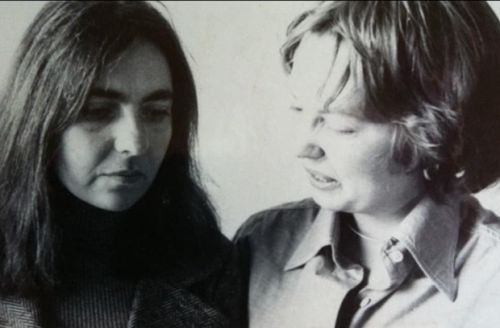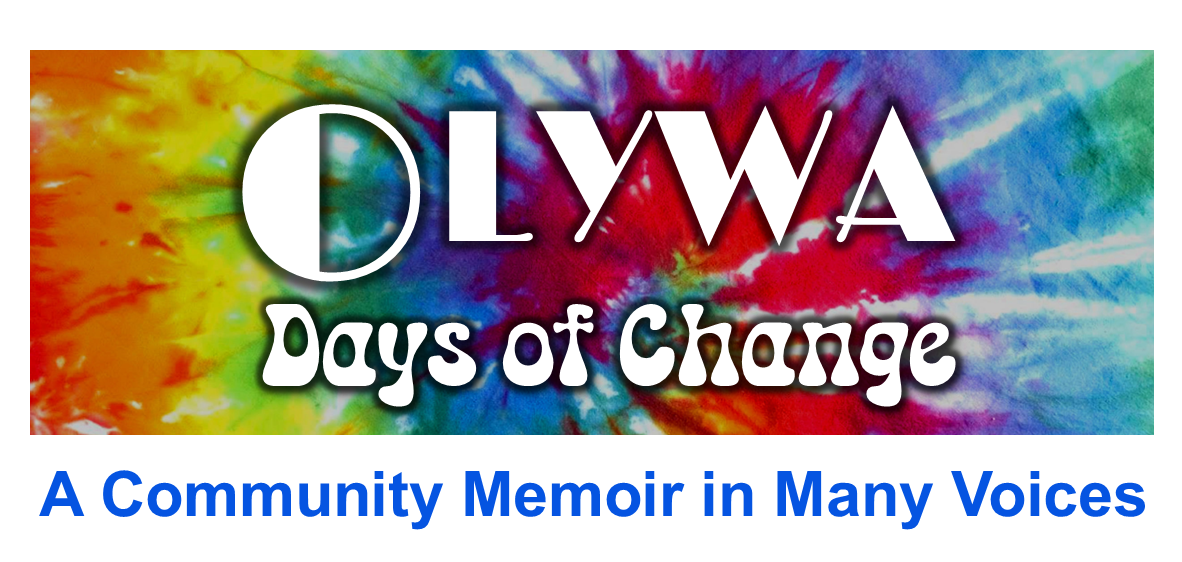ARRIVALS
Coming to Olympia
By Susan Christian
New England was stupidly cold in the winter. I was a painter supporting myself as an office temp. I wore miniskirts. Cold legs, cold feet.

I spent a school year teaching Marilyn Frasca’s students at a small liberal-arts college that Marilyn left behind in order to teach at Evergreen. It was New Hampshire, which was also very cold, but I didn’t have to wear the miniskirts, so it was better. Teaching seemed natural. I was a beginner.
The dean that year wasn’t the dean who had hired me. At the end of the year, before I had time to ask, he sent me a letter saying they didn’t want me back. The students had done well with me and protested, but it gave me a reason to move myself to L.A. where there were artists I admired and I knew the palm trees swayed in the balmy Pacific breezes.
I drove a fifteen-year-old fourth-hand Peugeot station wagon across the northern United States in early September of 1971. The freeways weren’t built yet. Every forty miles or so I would park by the side of the road and draw the landscape, whatever it happened to be. I parked behind motels at night and slept in the car.
I had never seen such a beautiful place as the western side of the Cascades. I drove to Olympia, little and peaceful. I found Marilyn living in a small old house with a big chicken coop. I slept in the chicken coop which was also Marilyn’s studio. Now the spot has a Big Lots store on it. The land where the mall is now, across West 9th Street, was acres of Scotch broom.
I got a crap job typing invoices for a publishing startup that was renting space at Evergreen. Evergreen was about two years old and not yet completely up to speed, but there was a tiny, tiny intaglio printmaking shop. I would go there after my typing job every day and make prints.
In March a painting teacher fell ill and I was recruited to see her students through the end of the year. Cappy Thompson was a student in that program. She hated me, but she got over it. Dennis Hastings was also a student in that program, and he taught us to say things were bad if what we meant was that they were good.
I was making big abstract paintings on raw unstretched canvas. Jo and Thad Curtz still have one in their living room. Also tiny drawings in the print studio. I was perfectly happy. I liked going to SeaMart, which had everything. I was young, and in love with someone. I’d forgotten about California.
People in Washington didn’t have any accents. They all spoke like people on TV, like Americans. I was thrilled. In New York and Boston there were six kinds of immigrants from Europe, but not here. I thought I had found a classless society. I learned to hear people’s speech patterns better when I was employed to work with kids in a prison south of town.
Marilyn Frasca and Lynn Patterson and I had a plan to buy a farm and be farmer-intellectuals. But Lynn found a nice little house on a hillside above a bay and bought it. The idea of the farm seemed to have been forgotten. But there was a big oyster processing factory on the shore. It was not an inviting structure, but the bay was exceptionally beautiful. I hired a student to build stuff into it that made it increasingly livable, and other students moved in and helped me make the payments. I bought everything I ever needed at SeaMart. When the first summer came, I bought masses of white paint and all the people I had met came over one day and we painted the whole thing. Before that it was institutional hospital green, weathered in character. Now I myself am very weathered. Many years after I arrived in Olympia, I got married to RickMcKinnon, who had kids, and we acquired more kids and lived by the bay till everyone who was going to grow up did grow up. I still live in the oyster factory with another generation of Evergreen students as renters. I’ve had lots of jobs. The most fun job was providing art therapy in downtown Olympia after getting a sketchy M.A. at Antioch. People I love have died, and soon I will too.
We encourage readers to use the form below to make comments and suggestions. Disclaimer
